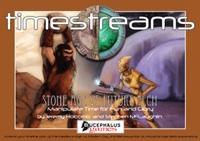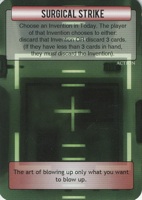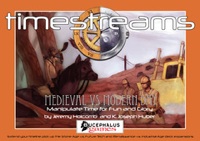
|
About OgreCave and its staff
|

|
by Dennis Hancock
Recently, I was fortunate enough to get my paws on two copies of Timestreams, 'Stone Age vs. Future Tech' as well as 'Medieval vs. Modern'. Timestreams is a non-collectible, expandable, time travel card game where players compete to seed the timeline and insure that their inventions survive the test of time. Timestreams is recommended for 2-6 players of ages 8 and up. Each set can be played individually with two players or combined with other sets to increase the maximum number of players by one or two per set. The game can be completed in approximately 45-60 minutes for a 4-6 player game, with smaller size games taking only marginally less time. So, without further adieu, strap yourself into your seat, keep your arms and legs inside the cabin at all times, and please refrain from any contact with inhabitants you might meet on our journey - we wouldn't want to taint the Timestreams.
Presentation I've said it before and I'll say it again, I am a big fan of small, easily understood rulebooks. Timestreams is a good example of this. The rulebook is clearly laid out in order of game play and easily understood. At first glance you may be confused, but play through one round and you will quickly understand everything by the time it is your turn to play another card. One of the best things about Timestreams is, if there are any special rules associated with certain cards, they are printed directly on the card. No more searching the rulebook to find out what a certain card does.
Artwork Artwork is one of those items that can make or break a game. In the case of Timestreams, it's the tasty, low fat, full flavor frosting on the cake. Now you may be thinking, "This is nothing special, there are plenty of games out there that don't reuse artwork." You're right, there are, but there is something different about Timestreams. Each card looks like a piece of art. The illustrations are just wispy and dreamy enough to evoke a sense of time. The artists pretty much nailed the Time theme they were going for.
The Gameplay Timestreams has two phases of gameplay, the Seeding Phase and the Scoring Phase. In the Seeding Phase, players take turns playing Action or Invention cards in order to seed the Timestreams, or they may pass their turn. Action cards have an instant effect and generally prevent players from using other actions, or they destroy or move inventions throughout the different Eras. Invention cards represent different inventions throughout history; some of the Stone Age inventions include Herbalism, Fire, The Wheel, and Fermented Fruit. Each Invention has either a Play action associated with it (not to be confused with Action cards) or a Score action. Play actions from an invention card occur when the card is played in one of the Eras, or it can sometimes be triggered when a player does something to affect that card. Score actions only take place during the scoring phase, but can have a dramatic effect on who gets to score points. Once all players have consecutively passed their turn, play in the current era ends and all players draw more cards and move on to the next era.
In the Scoring Phase, players discard all of the cards in their hand and begin tallying the Score effects on each card, starting with the first card in the Stone Age era. After the Scoring effect has been completed, or if that card has no Score effect, the next consecutive card scoring effect occurs. Some Score effects may destroy or move cards above or below them, causing players to miss out on scoring opportunities or allowing new scoring opportunities. The Score effects are determined through the first six scoring slots in an era, unless this number has been increased or decreased by another card. Once the allowed Score effects of an era have been tallied, the remaining cards in that era are discarded to the 'dustbin of history', never to be heard from again. Scoring continues in this manner until all appropriate Score effects have been played in each era. The invention cards, which remain in scoring slots, are returned to their respective players. Each player then tallies up the numerical value of each card and adds it to their score total. The player with the highest number of points wins the game. Timestreams wasn't all sunshine and roses, and we did run into a couple of issues we weren't sure how to resolve. Ultimately we ended up making a call and resolved ourselves to contact Bucephalus later on. The first issue was with the 'Navigation' invention card. Navigation has a Play Effect, which states: "You may play your next invention in yesterday or tomorrow." Some of the players thought the player could play an invention in yesterday or tomorrow on their next turn. However, the rules state that Play Effects take place immediately upon playing, so other players took this to mean the player immediately got to play another invention, per the rules on the card. Another issue came up with a card named Herbalism, which has a Reaction effect, the rulebook only talks about Play effects or Score effects. The card states "Play this card when another player plays an action card. Cancel all effects of that card and then discard Herbalism". We decided invention cards had to be in play before any effects on the card may be used, though I now suspect we were in error. A word to the wise: read the cards carefully and try not to overanalyze! There also seemed to be a number of cards in all of the decks with special effects that only trigger on 'Art' cards, but there didn't seem to be many 'Art' cards that came up during play. I've sent email to Bucephalus Games to clarify some of the issues we had, but have not heard from them yet. To be fair, it is the week of Gen Con and they are likely extremely busy. When I do hear back from them I will happily post an addendum.
Replayability
Conclusions
Ratings
|
||||
 Timestreams
Timestreams Normally I would include the artwork when describing the contents and
their quality, but I was so impressed I felt I had judge the art
independently. Each and every card in the box is beautifully detailed in
full color. All of the illustrations appear to be some combination of
watercolor, chalk, and ink; somebody spent a lot of time on the artwork.
Some games like to re-use artwork multiple times, which is fine to a
degree, and even Timestreams does this to some extent, but as the
exception rather than the rule. In the Medieval deck I counted 26
completely different full color illustrations, while the Modern deck had
24 different illustrations. That comes to 56 unique high quality
illustrations in one set alone. The era cards are just about the only
artwork that is copied over between the different sets, and for good
reason - they are the cards that tie each set together. Each card also
includes a title, a description stating how the card is used, its point
value, and a small, sometimes historic, sometimes humorous blurb about
the card.
Normally I would include the artwork when describing the contents and
their quality, but I was so impressed I felt I had judge the art
independently. Each and every card in the box is beautifully detailed in
full color. All of the illustrations appear to be some combination of
watercolor, chalk, and ink; somebody spent a lot of time on the artwork.
Some games like to re-use artwork multiple times, which is fine to a
degree, and even Timestreams does this to some extent, but as the
exception rather than the rule. In the Medieval deck I counted 26
completely different full color illustrations, while the Modern deck had
24 different illustrations. That comes to 56 unique high quality
illustrations in one set alone. The era cards are just about the only
artwork that is copied over between the different sets, and for good
reason - they are the cards that tie each set together. Each card also
includes a title, a description stating how the card is used, its point
value, and a small, sometimes historic, sometimes humorous blurb about
the card.
 In the Seeding Phase, players take turns trying to place their cards
within the first six timeslots of each era. These six slots are the only
slots that will be scored during the scoring phase. Some cards may
increase or decrease the number of scoring slots in each era, but these
are rare and should be used very carefully. Careless use of these cards
may allow your competitors to take advantage of the increased scoring
slots. Once all eras have been played and all players have passed in the
Future Tech era, Phase one ends and the Scoring Phase begins.
In the Seeding Phase, players take turns trying to place their cards
within the first six timeslots of each era. These six slots are the only
slots that will be scored during the scoring phase. Some cards may
increase or decrease the number of scoring slots in each era, but these
are rare and should be used very carefully. Careless use of these cards
may allow your competitors to take advantage of the increased scoring
slots. Once all eras have been played and all players have passed in the
Future Tech era, Phase one ends and the Scoring Phase begins.
 Alone, one set of Timestreams is a good game and has decent
replayability - when combined with another set, though, replayability
practically triples. Bucephalus Games indicates on the game box the
strategy and luck ratings are three and two out of five, respectively. I
disagree. Placing cards during the Seed Phase is all about strategy. I
found myself wondering what cards to play first. Should I play the low
point 'Cloth' invention card, which allows me to protect another
invention? Or should I play my higher point 'Domesticated Animals'
invention and risk somebody destroying it before my next turn comes
around? There is more to it than just that - if I play my low point card
first, there may not be any more scoring slots available when it comes
time to play my next card. This is where the element of luck comes in.
The luck rating should at least be a three rather than a two, as a
moderate degree of luck is involved. You never can tell when you are
going to get that good card during your draw phase which might allow you
to play two cards instead of one, or for example, play the Stone Age
'Smoke Signals' card before one of your opponents plays their Modern Age
'Surgical Strike' and destroys your carefully laid plans. With multiple
Timestreams sets, the replayability options are endless and the
outcome of each game could be different every time.
Alone, one set of Timestreams is a good game and has decent
replayability - when combined with another set, though, replayability
practically triples. Bucephalus Games indicates on the game box the
strategy and luck ratings are three and two out of five, respectively. I
disagree. Placing cards during the Seed Phase is all about strategy. I
found myself wondering what cards to play first. Should I play the low
point 'Cloth' invention card, which allows me to protect another
invention? Or should I play my higher point 'Domesticated Animals'
invention and risk somebody destroying it before my next turn comes
around? There is more to it than just that - if I play my low point card
first, there may not be any more scoring slots available when it comes
time to play my next card. This is where the element of luck comes in.
The luck rating should at least be a three rather than a two, as a
moderate degree of luck is involved. You never can tell when you are
going to get that good card during your draw phase which might allow you
to play two cards instead of one, or for example, play the Stone Age
'Smoke Signals' card before one of your opponents plays their Modern Age
'Surgical Strike' and destroys your carefully laid plans. With multiple
Timestreams sets, the replayability options are endless and the
outcome of each game could be different every time.